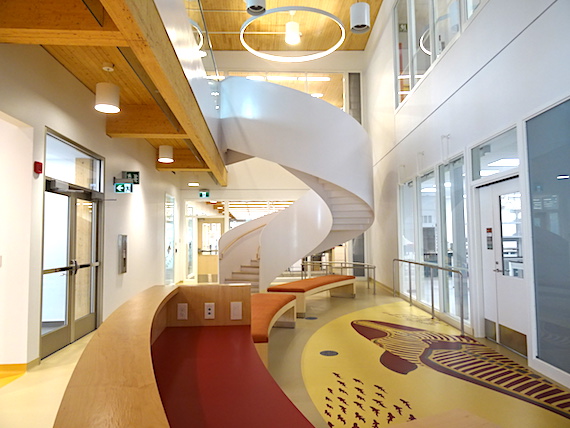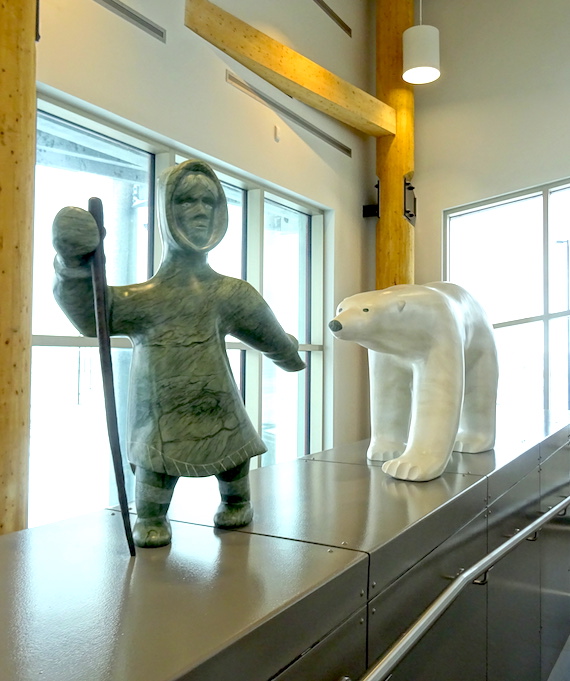The jewel of Canadian Arctic research remains under wraps
More than a year after its planned July 1, 2017 opening, the Canadian High Arctic Research Station in Cambridge Bay is still closed to the public.

CAMBRIDGE BAY — When the low-lying sun strikes the Canadian High Arctic Research Station in Cambridge Bay at this time of year, it looks like a big, shiny, copper-colored treasure chest.
But, unless you’re working at CHARS, you can’t see what’s inside this striking $200-million complex.
The main science building, at 7,900 square meters, with its stunning gems of Inuit art and interior design, part of which is supposed to be open to the public, remains closed.
Although the building been occupied by staff for months, there’s still no official opening date set for CHARS, although some people in this western Nunavut community of about 1,700 people did get a chance to visit during a July open-house event.
[Trudeau’s budget looks after science, giving Arctic researchers hope]
CHARS, which also includes a massive maintenance building, said to be the largest building in the Arctic, and two residential triplexes, was first set to open on July 1, 2017, with Prime Minister Justin Trudeau in attendance.
That opening was then delayed to October 2017, then to November after the Nunavut election and again to February 2018, in conjunction with the Kitikmeot Trade Show.
In late September, Lynn Berrouard, the external communications manager for Polar Knowledge Canada, said “while limited operations are already taking place at the CHARS campus, the date of an official opening has yet to be set.”
Chief among those delays in moving to an official opening appears to be a major administrative and legal complication.
The Federal Real Property Act had to be amended to allow Polar Knowledge Canada, which oversees CHARS, to be treated as a Crown corporation for the purpose of assuming ownership of CHARS.
“We have to make a distinction between the organization and the building. The organization, moving forward, will be, and continues to be, a departmental corporation. For the purposes of taking on the legal title of the building, under the Federal Real Property and Federal Immovables Act, it will be considered a Crown corporation,” said Wayne Walsh, who is the director general of Northern Affairs, then under Indigenous and Northern Affairs Canada, speaking to a Senate committee on the Arctic last May.
That amendment, according to an online copy of the act, looks like it was done in June, fixing a legal loophole in the original drafting of the CHARS Act in 2014.
But the transfer of ownership hasn’t taken place yet, a media spokesperson from Crown-Indigenous Relations and Northern Affairs Canada told Nunatsiaq News Oct. 2.
“While plans to transfer the asset from Crown-Indigenous Relations and Northern Affairs Canada to Polar Knowledge Canada have commenced, the final transfer of the lands and campus cannot take place until full substantial completion is achieved,” said Stephanie Palma.
“While full substantial completion of the station remains outstanding, the campus has received partial substantial completion, which allows for Polar Knowledge Canada to operate in the accepted areas of the station.
“As with any project of this size and complexity and to ensure the health and safety of occupants, due diligence is required in order for Public Services and Procurement Canada to grant final substantial completion for the project. While some areas of the station have been granted final substantial completion, thereby allowing Polar Knowledge Canada to operate in those areas, work and testing on other areas remains ongoing. Some of the labs in the station are among the areas which have not yet been granted final substantial completion.”
While closed to the public, CHARS has the money to keep the heat and lights on.
The total operating cost of the physical campus is currently estimated to be about $7.1 million a year. That covers several million dollars worth of fuel to heat the campus, as well as contracts for maintenance and other consumables.
“Our overall budget for the organization (Polar Knowledge Canada) is now approaching $29 million per year,” David J. Scott, Polar Knowledge’s president and CEO at that same Senate hearing last May. “So approximately 25 per cent of our overall budget, as we move forward, will be operating costs of the physical infrastructure on the research campus in Cambridge Bay.”
About $300,000 a year goes for an internet connection via satellite, he said.
“It is a thin connection and it is an expensive one to have a dedicated link,” he said. “Once our bandwidth increases we will be able to reach out more virtually to other communities across the North and around the world to bring others virtually to Cambridge Bay and bring Cambridge Bay and what we do across the North and around the world”
Public use of the main building is planned for, Scott also said in May, adding that “an important feature that distinguishes this research facility from all others in the polar regions in that it is welcoming of members of the public; is not limited to scientific expeditioners only.”
CHARS also plans to work in partnership with Nunavut Arctic College’s Environmental Technology Program through use of the GIS, or Geographic Information Systems laboratory, he said.
The projected total number of staff for CHARS is 58, although in May that number stood between 45 and 50, with only about half the staff actually working in Cambridge Bay.
“The remainder are here in the Ottawa office,” Scott said.
That’s hardly the local job bonanza that many hoped for, but to date, the CHARS construction gave $58 million to an Inuit benefits plan through contracting, employment and training.
For now, the main science building’s doors remain locked, even if everything inside is spotless, ready and set to go.
A tour provided to Nunatsiaq News by an employee of Polar Knowledge, that oversees the complex, did provide a look at the impressive work from Inuit artists which adorns the expansive public spaces of the main science building.
There are carvings by many well-known Inuit artists, such as a polar bear by Puvirnituq’s Peter Bay Ittukalak and another of an elder and an alabaster polar bear by Kuzy Curley of Cape Dorset, along with floor art work by Sammy Kudluk of Kuujjuaq and by the late Tim Pitseolak of Cape Dorset. The elders of the Kitikmeot Historical Society also made a series of large wall-hangings.
The public area, dubbed the Knowledge Sharing Centre, also contains a circular space for talks or films, a translation booth, fully-equipped radio broadcast room, a large, open seating area, a kitchen, coffee area, empty laboratories, and a board room that looks as if it could accommodate the entire Nunavut legislature.



